Abstract
In a retrospective study of patients developing hepatitis or persistent serum glutamic oxaloacetic transaminase (SGOT) elevations while receiving isoniazid, it was found that the lymphocyte transformation test (LTT) was positive in nineteen cases (95%) in response to stimulation by isoniazid, isonicotinic acid and conjugates of these compounds with human serum albumin. However, no significant amount of antibody against isoniazid was detected in the sera of these patients by a sensitive radioimmunoassay. By contrast, no positive LTT was seen in normal controls or in patients receiving isoniazid without evidence of liver damage, while in patients with transient SGOT abnormalities, the LTT was positive only at the time of liver dysfunction. There was no correlation between the degree of lymphocyte transformation and the severity of liver damage. However, there were differences in the patterns of response to the four stimulatory preparations used. Thus patients with overt hepatitis most frequently responded to isoniazid, while individuals with only SGOT abnormalities showed stimulation in the LTT more often with a conjugate of isonicotinic acid and human serum albumin. It appears, therefore, that the presence of isoniazid-induced liver damage is associated with the presence of cellular hypersensitivity to the drug. The differences in lymphocyte reactivity in the two groups might indicate a potential means of predicting which individuals are at increased risk of developing overt hepatitis when exhibiting evidence of minor liver dysfunction while receiving isoniazid.
Full text
PDF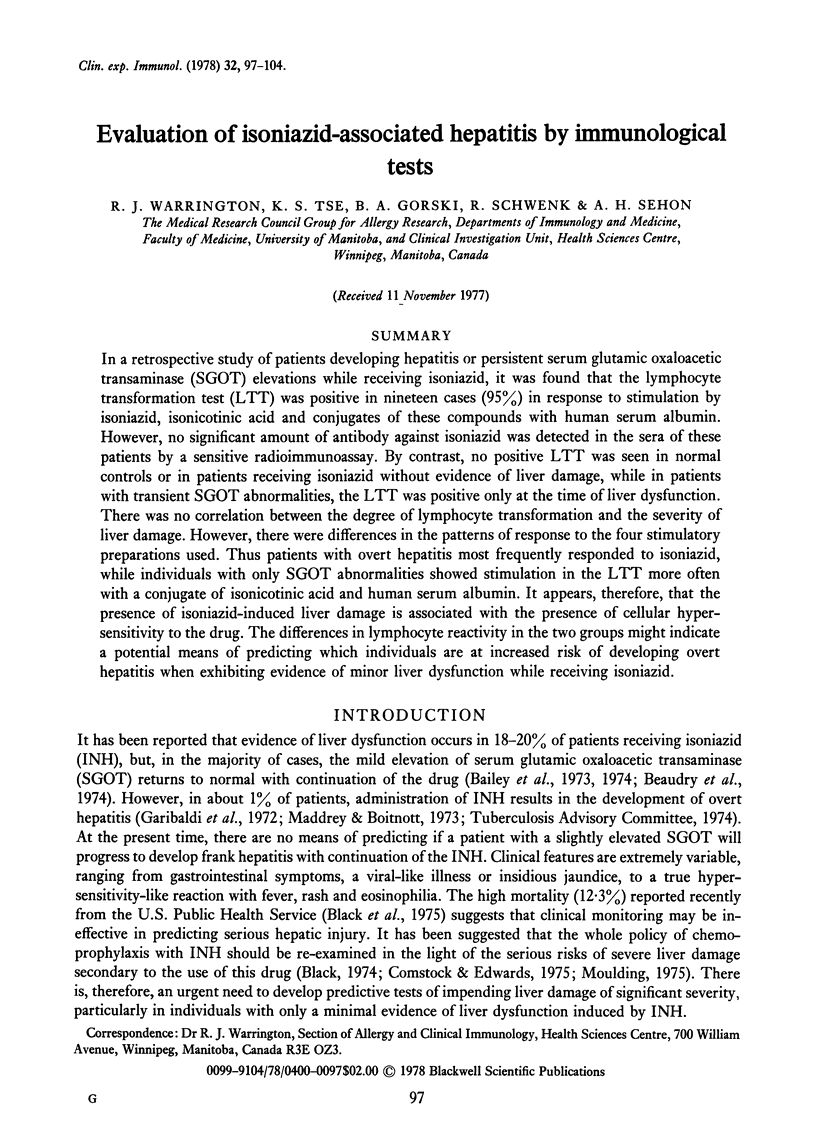
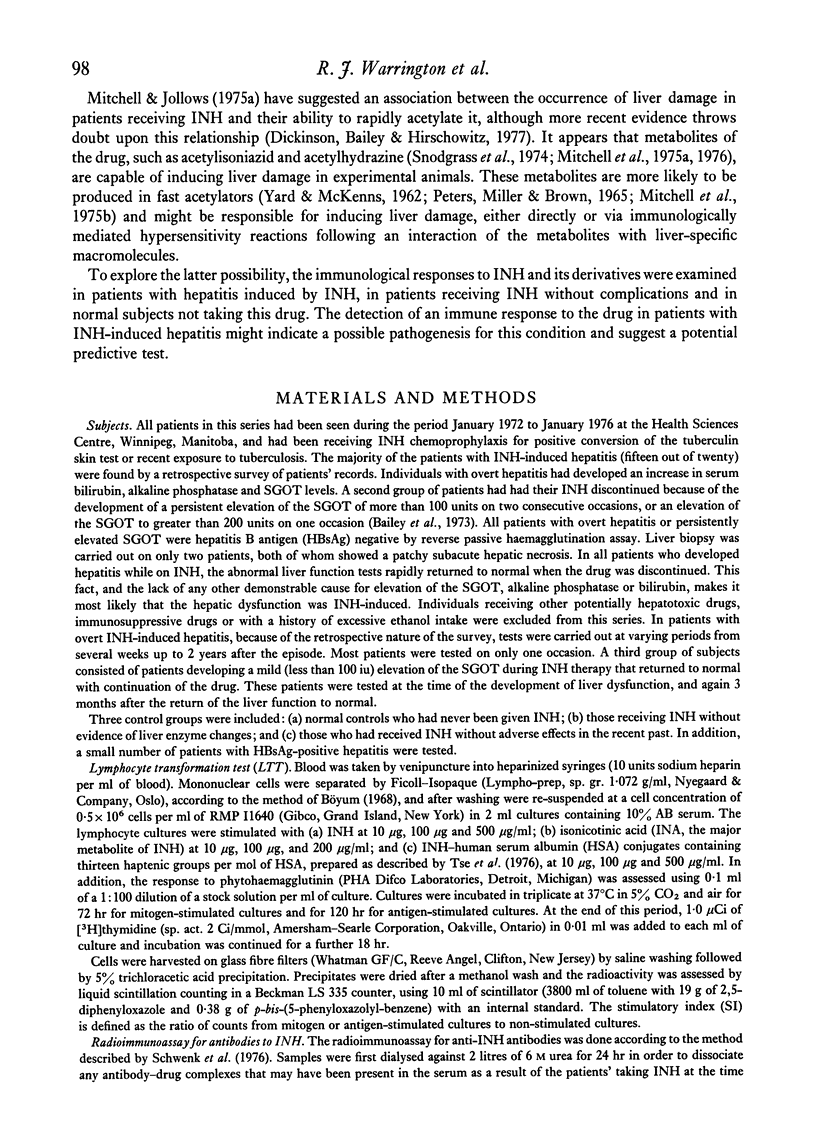
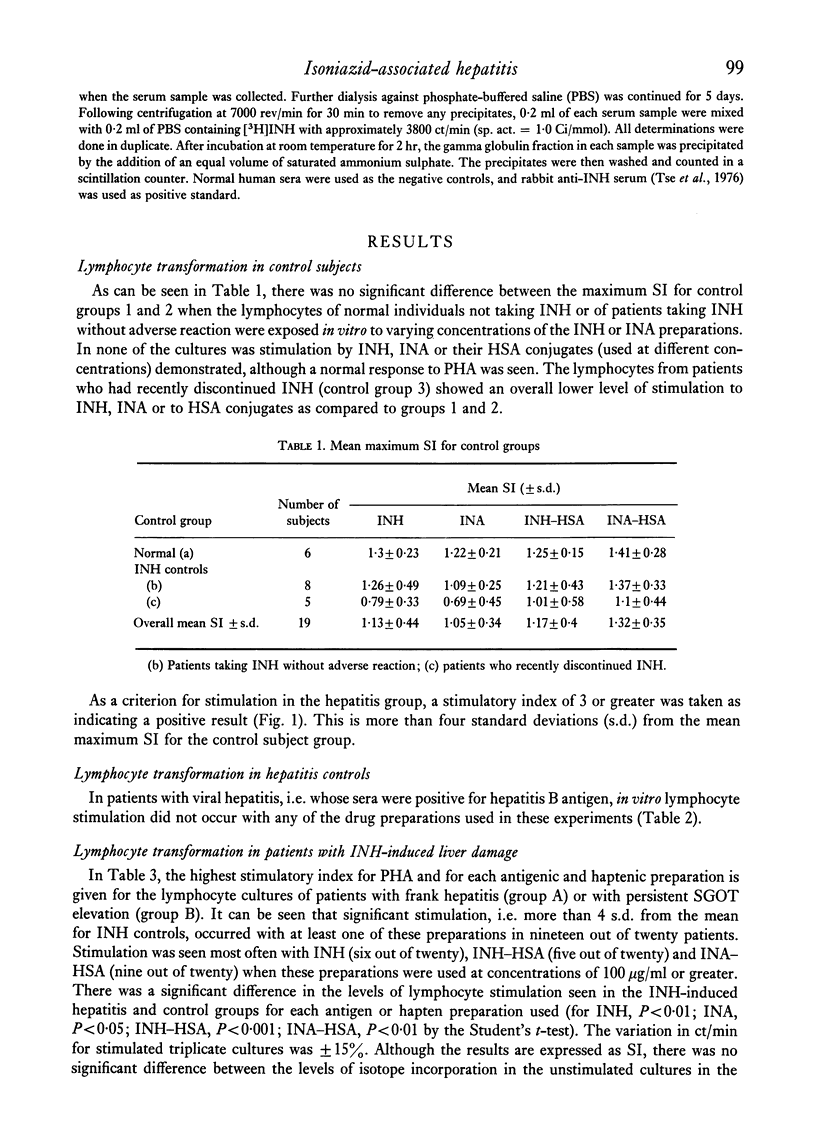
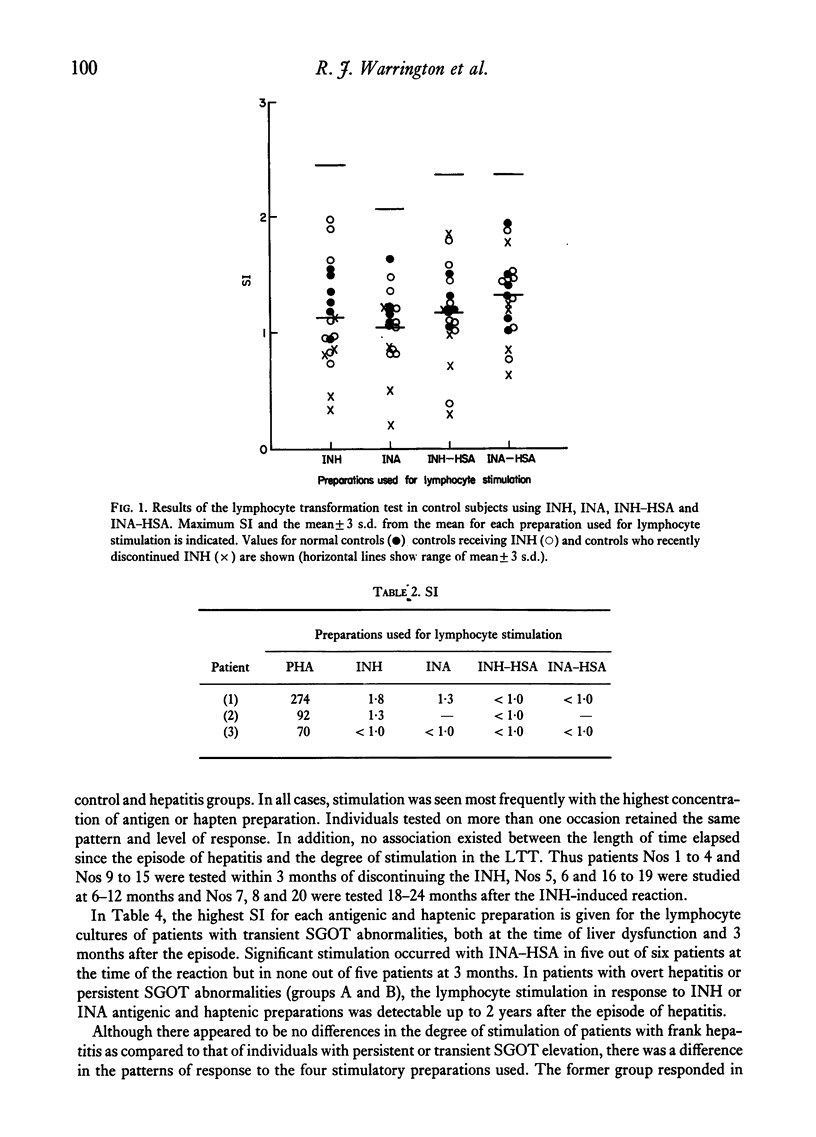

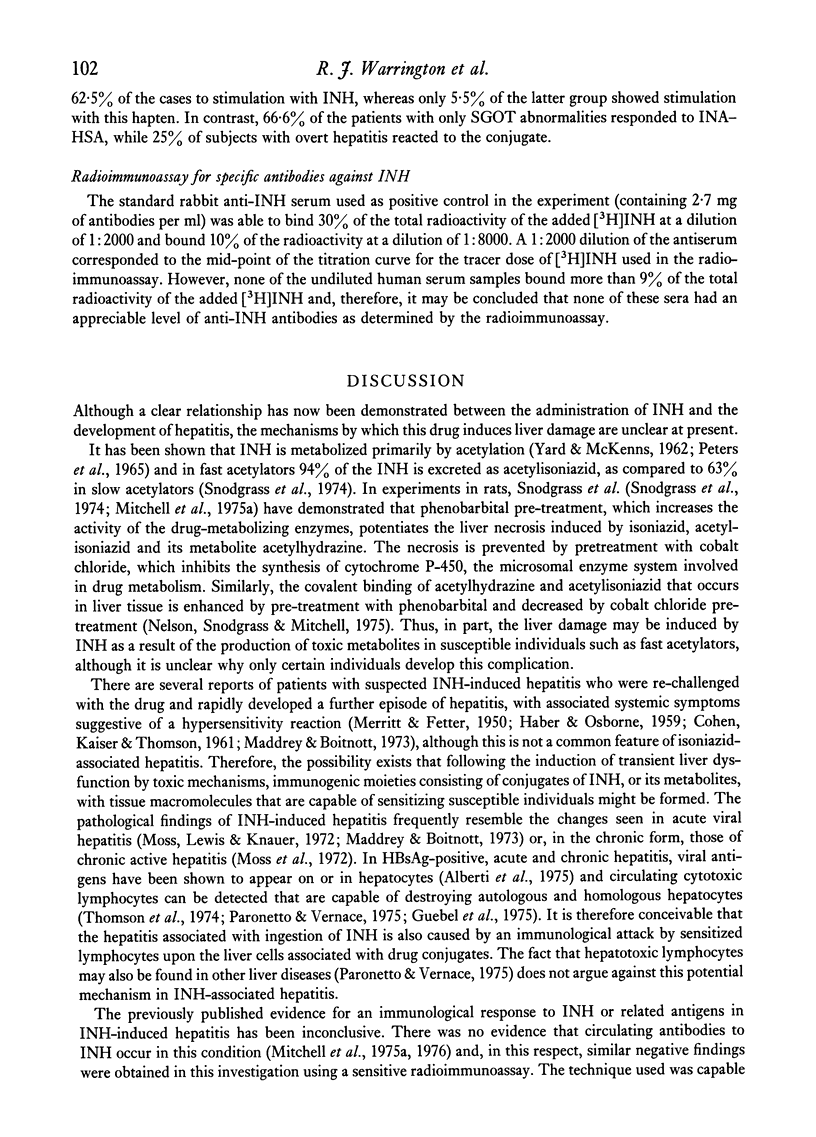

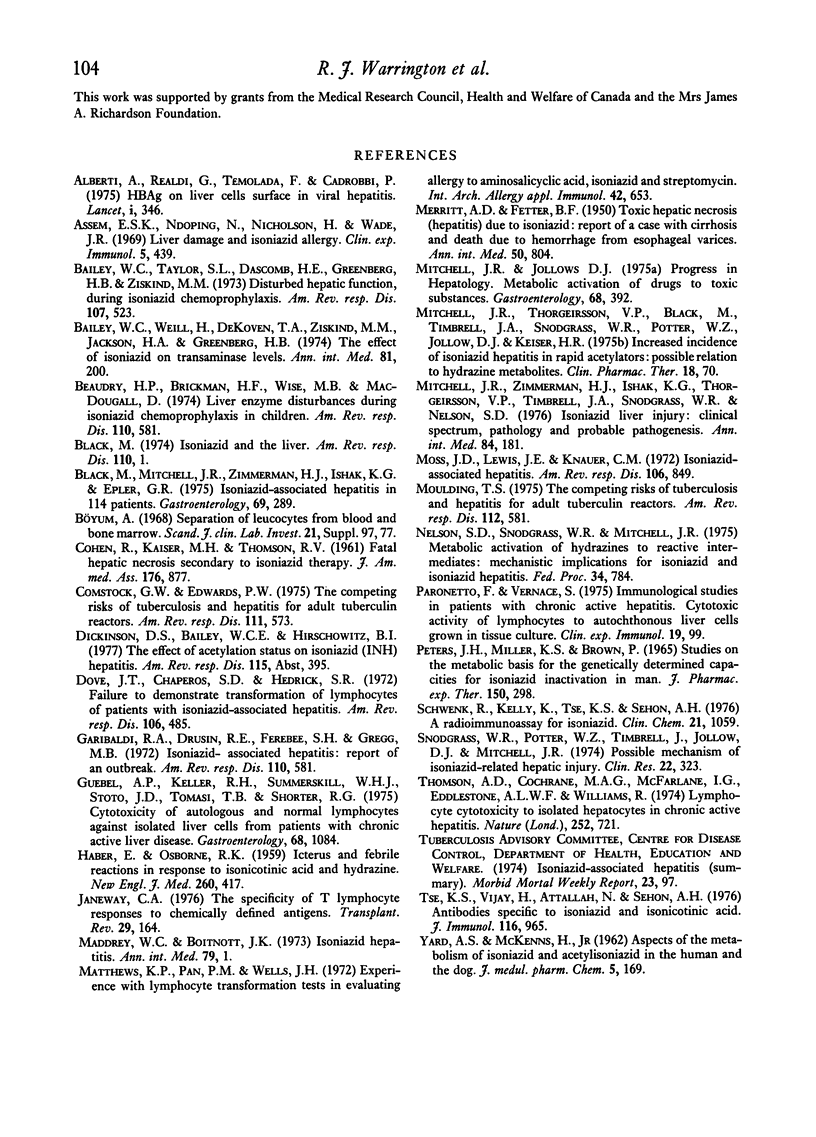
Selected References
These references are in PubMed. This may not be the complete list of references from this article.
- Alberti A., Realdi G., Tremolada F., Cadrobbi P. Letter: HBAg on liver-cell surface in viral hepatitis. Lancet. 1975 Feb 8;1(7902):346–346. doi: 10.1016/s0140-6736(75)91267-2. [DOI] [PubMed] [Google Scholar]
- Assem E. S., Ndoping N., Nicholson H., Wade J. R. Liver damage and isoniazid allergy. Clin Exp Immunol. 1969 Oct;5(4):439–442. [PMC free article] [PubMed] [Google Scholar]
- Bailey W. C., Taylor S. L., Dascomb H. E., Greenberg H. B., Ziskind M. M. Disturbed hepatic function during isoniazid chemoprophylaxis. Monitoring the hepatic function of 427 hospital employees receiving isoniazid chemoprophylaxis for tuberculosis. Am Rev Respir Dis. 1973 Apr;107(4):523–529. doi: 10.1164/arrd.1973.107.4.523. [DOI] [PubMed] [Google Scholar]
- Bailey W. C., Weill H., DeRouen T. A., Ziskind M. M., Jackson H. A. The effect of isoniazid on transaminase levels. Ann Intern Med. 1974 Aug;81(2):200–202. doi: 10.7326/0003-4819-81-2-200. [DOI] [PubMed] [Google Scholar]
- Black M. Editorial: Isoniazid and the liver. Am Rev Respir Dis. 1974 Jul;110(1):1–3. doi: 10.1164/arrd.1974.110.1.1. [DOI] [PubMed] [Google Scholar]
- Black M., Mitchell J. R., Zimmerman H. J., Ishak K. G., Epler G. R. Isoniazid-associated hepatitis in 114 patients. Gastroenterology. 1975 Aug;69(2):289–302. [PubMed] [Google Scholar]
- COHEN R., KALSER M. H., THOMSON R. V. Fatal hepatic necrosis secondary to isoniazid therapy. JAMA. 1961 Jun 10;176:877–879. doi: 10.1001/jama.1961.63040230013013b. [DOI] [PubMed] [Google Scholar]
- Comstock G. W., Edwards P. Q. The competing risks of tuberculosis and hepatitis for adult tuberculin reactors. Am Rev Respir Dis. 1975 May;111(5):573–577. doi: 10.1164/arrd.1975.111.5.573. [DOI] [PubMed] [Google Scholar]
- Dove J. T., Chaparas S. D., Hedrick S. R. Failure to demonstrate transformation of lymphocytes of patients with isoniazid-associated hepatitis. Am Rev Respir Dis. 1972 Sep;106(3):485–487. doi: 10.1164/arrd.1972.106.3.485. [DOI] [PubMed] [Google Scholar]
- HABER E., OSBORNE R. K. Icterus and febrile reactions in response to isonicotinic acid hydrazine; report of two cases and review of the literature. N Engl J Med. 1959 Feb 26;260(9):417–420. doi: 10.1056/NEJM195902262600904. [DOI] [PubMed] [Google Scholar]
- Janeway C. A., Jr The specificity of T lymphocyte responses to chemically defined antigens. Transplant Rev. 1976;29:164–188. doi: 10.1111/j.1600-065x.1976.tb00201.x. [DOI] [PubMed] [Google Scholar]
- MERRITT A. D., FETTER B. F. Toxic hepatic necrosis (hepatitis) due to isoniazid: report of a case with cirrhosis and death due to hemorrhage from esophageal varices. Ann Intern Med. 1959 Mar;50(3):804–810. doi: 10.7326/0003-4819-50-3-804. [DOI] [PubMed] [Google Scholar]
- Maddrey W. C., Boitnott J. K. Isoniazid hepatitis. Ann Intern Med. 1973 Jul;79(1):1–12. doi: 10.7326/0003-4819-79-1-1. [DOI] [PubMed] [Google Scholar]
- Mitchell J. R., Jollows D. J. Progress in hepatology. Metabolic activation of drugs to toxic substances. Gastroenterology. 1975 Feb;68(2):392–410. [PubMed] [Google Scholar]
- Mitchell J. R., Thorgeirsson U. P., Black M., Timbrell J. A., Snodgrass W. R., Potter W. Z., Jollow H. R., Keiser H. R. Increased incidence of isoniazid hepatitis in rapid acetylators: possible relation to hydranize metabolites. Clin Pharmacol Ther. 1975 Jul;18(1):70–79. doi: 10.1002/cpt197518170. [DOI] [PubMed] [Google Scholar]
- Mitchell J. R., Zimmerman H. J., Ishak K. G., Thorgeirsson U. P., Timbrell J. A., Snodgrass W. R., Nelson S. D. Isoniazid liver injury: clinical spectrum, pathology, and probable pathogenesis. Ann Intern Med. 1976 Feb;84(2):181–192. doi: 10.7326/0003-4819-84-2-181. [DOI] [PubMed] [Google Scholar]
- Moss J. D., Lewis J. E., Knauer C. M. Isoniazid-associated hepatitis. A study of five cases. Am Rev Respir Dis. 1972 Dec;106(6):849–856. doi: 10.1164/arrd.1972.106.6.849. [DOI] [PubMed] [Google Scholar]
- Moulding T. S. Letter: The competing risks of tuberculosis and hepatitis for adult tuberculin reactors. Am Rev Respir Dis. 1975 Oct;112(4):581–582. doi: 10.1164/arrd.1975.112.4.581. [DOI] [PubMed] [Google Scholar]
- Paronetto F., Vernace S. Immunological studies in patients with chronic active hepatitis. Cytotoxic activity of lymphocytes to autochthonous liver cells grown in tissue culture. Clin Exp Immunol. 1975 Jan;19(1):99–104. [PMC free article] [PubMed] [Google Scholar]
- Peters J. H., Miller K. S., Brown P. Studies on the metabolic basis for the genetically determined capacities for isoniazid inactivation in man. J Pharmacol Exp Ther. 1965 Nov;150(2):298–304. [PubMed] [Google Scholar]
- Schwenk R., Kelly K., Tse K. S., Sehon A. H. A radioimmunoassay for isoniazid. Clin Chem. 1975 Jul;21(8):1059–1062. [PubMed] [Google Scholar]
- Thomson A. D., Cochrane M. A., McFarlane I. G., Eddleston A. L., Williams R. Lymphocyte cytotoxicity to isolated hepatocytes in chronic active hepatitis. Nature. 1974 Dec 20;252(5485):721–722. doi: 10.1038/252721a0. [DOI] [PubMed] [Google Scholar]
- Tse K. S., Vijay H., Attallah N., Sehon A. H. Antibodies specific to isoniazid and isonicotinic acid. J Immunol. 1976 Apr;116(4):965–969. [PubMed] [Google Scholar]


